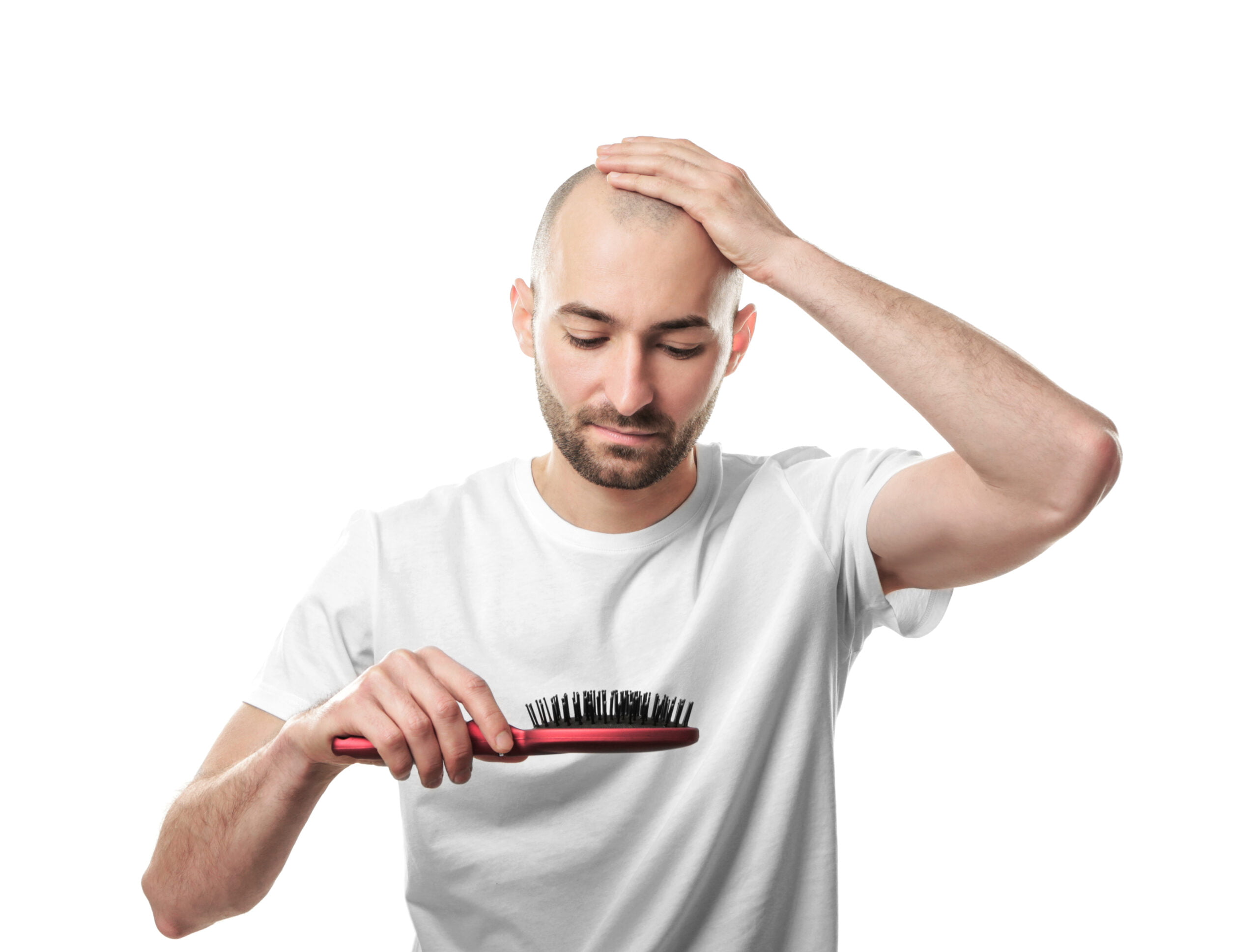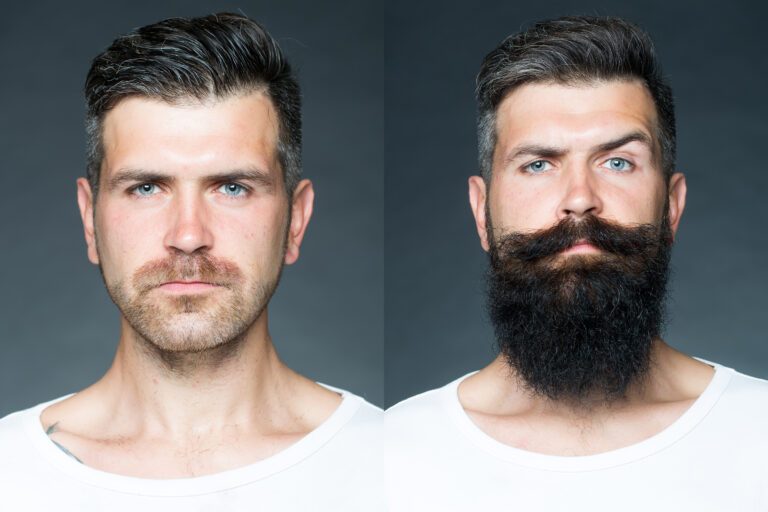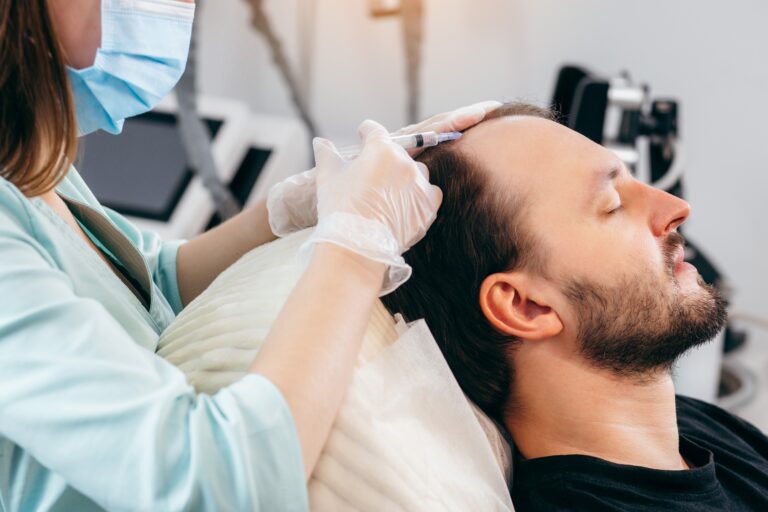Can Minoxidil Cause Hair Loss? The Shedding Phase Explained
Millions of people suffer from receding hairlines, hair loss, and bald patches. Commonly, this condition is caused by genetics, hormones, and other health conditions.
Others might discover that their hair loss is triggered by their lifestyle or by using hair treatments like rogaine, a minoxidil brand.
This begs the question: Can minoxidil cause hair loss? When you use minoxidil for the first time, it’ll trigger even more hair loss. You shouldn’t panic, as it’s completely normal.
Usually, this increase in hair fall is referred to as minoxidil shedding. It’s a sign that you’re starting to grow healthy, new hair.
In this article, we’ll look at the facts behind minoxidil shedding phases. Not only that, but we’ll also explore the facts to see if using this treatment can truly cause further hair loss.
What Is Minoxidil?
Over the years, minoxidil has been considered one of the most effective hair growth treatments. But what exactly is minoxidil?
In general, minoxidil comes in two strengths and can be used topically or orally. The FDA has approved the 2% formula to treat women’s hair loss, while men can use the 5% solution.
Interestingly, minoxidil can stimulate hair growth by enlarging your hair follicles. According to research, this treatment can expand blood vessels and enhance blood flow to the hair follicles, which provides the nutrients and oxygen required for hair growth.
Moreover, it may also promote hair follicle cell activity and extend the growth phase of your hair cycle. This activity results in thicker and longer hair.
Minoxidil Shedding Timeline
Generally speaking, it’s common to see increased hair fall after taking minoxidil. It’s a temporary condition caused by minoxidil that indicates your hair growth cycle is changing from one phase to another.
While it may cause anxiety to some, slight hair shedding isn’t permanent and usually goes away within a few months.
There are three stages of hair growth: the telogen (resting phase), catagen (transition phase), and anagen (growth phase). By using minoxidil, you can reduce the resting phase and prolong the growth phase of your hair growth cycle.
Additionally, this hair growth cycle triggers the transition phase, causing increased hair loss.
Even though you might see your hair thinning, it’s a sign that the treatment is working. Shedding old hair encourages extending the growth phase, promoting more new hair growth than usual.
So, if you’ve just started using minoxidil, be patient and think of the treatment’s long-term effect.
Though it may feel like a never-ending cycle, your hair will likely look better in a couple of months or so – and much better after a year.
How Long Does Minoxidil Shedding Last?
Minoxidil shedding usually occurs within two to four weeks and may last up to eight weeks. After this time, it settles down, and you’ll start to see hair growth.
Specifically, research shows that most men see results as early as four to six months, while others require a year to see the treatment’s full effects.
Remember that not everyone experiences minoxidil shedding. Sometimes, the shedding severity may vary from person to person.
Can Minoxidil Cause Hair Loss?
Minoxidil can lead to short-term hair loss for roughly two weeks. You might observe that your hair grows back smoother than usual until the treatment takes maximum effect.
Additionally, if your body responds to minoxidil well, the consistent application will result in growing the same hair color and volume as the rest of your hair.
While hair shedding is evident, according to the American Academy of Dermatology Association, minoxidil showed its effectiveness in promoting hair growth rates in both men and women.
Minoxidil may pose adverse effects like other medications. The primary side effects often include:
- Itchiness
- Redness
- Scalp dryness (flaking)
When Does Rogaine Shedding Stop?
Even though there isn’t much you can do to stop Rogaine shedding or predict if you’ll get it, it’s worth noting that the gravity of the effects depends on the minoxidil concentration you’ll use.
For example, women and men who use 5% Rogaine foam may notice more hair growth than those who use the 2% strength. This fact also implies that more shedding can happen using a high-concentration Rogaine solution.
In most cases, the maximum effect of new hair growth may not be visible in the first four weeks. However, Rogaine shedding will still be in effect and usually stops after eight weeks. If you’re lucky, you may stop experiencing shedding as early as four weeks.
Minoxidil Shedding Phase
Every hair is in a unique phase of its growth cycle. The hair growth cycle usually includes hair shedding. This shedding can happen to anyone, even those with healthy, thick hair.
Normally, healthy hair follicles shed as many as 100 hair strands daily. This occurs as your hair transitions from its resting phase to its growing phase.
- Anagen Phase
The “growing” phase is the first stage of hair growth. During this phase, 90% of your hair follicles form new strands for two to six years. Although for some, a single hair strand continues to grow for more than seven years.
For the most part, different kinds of body hair vary in anagen phases. In particular, pubic and brow hairs’ anagen phase is shorter compared to your head hairs.
Your hair follicles continue to grow new hair unless they’re trimmed or once their growth cycle ends.
- Catagen Phase
The transition phase begins after the growing phase has been completed. Usually, this phase lasts about one to two weeks.
During this stage, hair growth stalls, and hair follicles dwindle. Likewise, your hair splits from your hair follicles but stays in place throughout the final days of development.
Approximately, 3% of your hair is in the transition phase.
- Telogen Phase
This phase is the hair’s “resting” stage. A portion of your hair begins falling out at the end of this three-to-four-month period.
According to a study, at least 10–15% of your hair strands are in this phase. Once your old hair has shed, new hair replaces it, starting the anagen phase again.
Minoxidil Shedding After 3 Months
It’s impossible to know exactly how your body will respond to any given treatment. It doesn’t matter if there are a few strands in the tub; many people experience some degree of minoxidil shedding. Besides, the timing of the shedding can be a bit sporadic.
Proof of this, minoxidil may take effect in just a few weeks of usage. Nonetheless, you should see the full effect could after three months.
Even though there’s no assurance that you won’t shed during this period, several minoxidil users noticed shedding. Still, the minoxidil shedding phase is unique to everyone.
The average period for minoxidil shedding is three months. Although, you may start to notice improvements as soon as two months.
If you’re still seeing minoxidil shedding after six months, speak with a dermatologist regarding other alternatives.
Minoxidil Shedding After 6 Months
In the initial 2–3 weeks of treatment, it isn’t unusual to notice a slight increase in hair loss.
As a matter of fact, not everyone experiences hair shedding. Those who experience more severe shedding tend to notice better hair growth with consistent minoxidil application.
However, if it’s been six months, and the shedding gets worse or you don’t see any results, it could be a sign of other underlying hair loss disorders.
Another possibility is that minoxidil could be the wrong product for you. Try using different treatments like Finasteride.
Others have more satisfaction with Finasteride compared to minoxidil. Given this, try to combine Minoxidil and Finasteride for an ultimate two-in-one hair regrowth solution.
Although it’s safe, it’s better to check with your doctor first before attempting this option.
To conclude, minoxidil’s effectiveness can vary depending on a person’s condition. Its efficacy depends on several factors, like the patient’s age, the severity of hair loss, and the root cause of it.
Takeaways
Minoxidil remains one of the top hair loss treatments. While you may experience shedding, it’s usually temporary and will stop after a few months of constant use.
Nonetheless, minoxidil is an effective and risk-free treatment for hair loss. Although, like other drugs, you have to consider the possible side effects.
Hence, see your doctor if you face any discomfort while using minoxidil.







